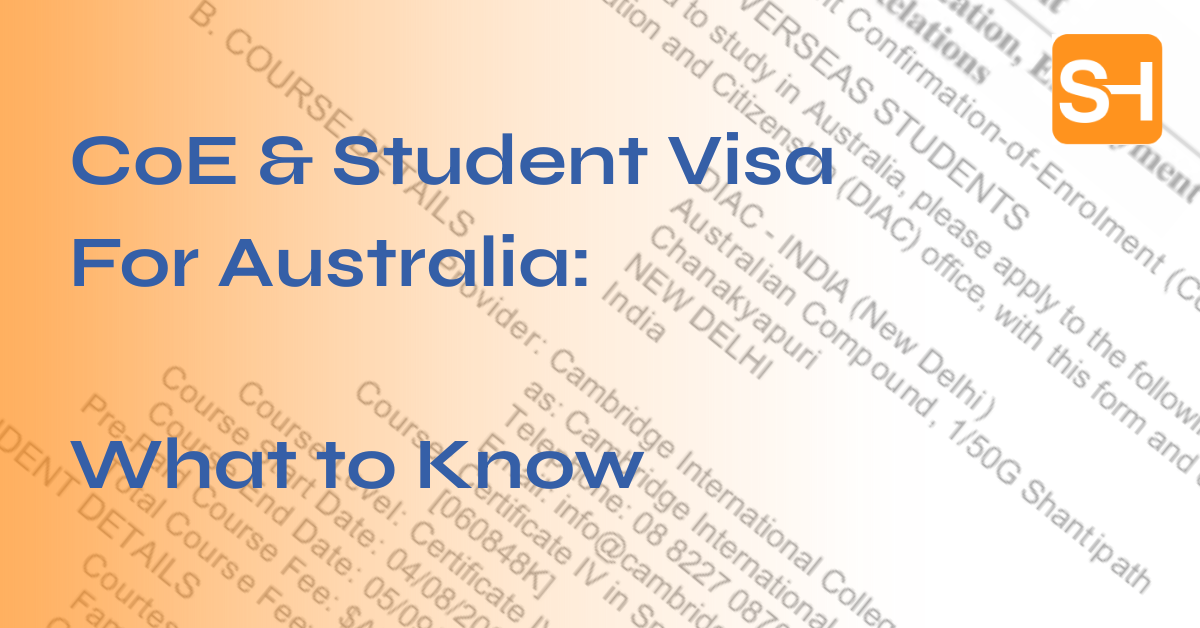Before you can even pack your bags or dream about that first sunrise over Bondi, there’s a crucial document standing between you and your Australian study adventure: the Confirmation of Enrolment (CoE). This tiny but mighty certificate is what your student visa for Australia revolves around. It’s the proof that you’re officially accepted by an Australian education provider. Without it, your visa application can’t even begin. In case you are already in Australia, it’s the document you need to take care of, meaning, with good attendance and academic progress, because, your education provider cancels it, the Department of immigration will proceed to cancel your visa.
So, let’s unpack what a CoE student visa Australia means, how to get one, what could cause you to lose it, and what to do if things go sideways with extensions or cancellations.
What Is a CoE and Why It Matters for Your Student Visa
A CoE is a digital certificate issued by your university, college, or school in Australia. It confirms that:
- You have been offered a place in a registered course.
- You’ve accepted that offer.
- You’ve paid the required tuition fees (at least the first instalment or the amount specified in the offer letter in order for the admissions team to issue a CoE.
Once your education provider issues the CoE, it’s uploaded to the Australian government’s system, linking directly to your student visa application.
Without a CoE, your visa application will not be processed. Think of it as the “golden ticket” that officially connects you to your chosen course and institution.
Beyond its bureaucratic importance, the CoE has deeper implications. It shapes:
- The length of your student visa.
- The official start and end dates of your study journey in Australia.
If your course dates change, for example, if you defer, withdraw, or extend your studies, your CoE needs to change accordingly. It’s a living document, not a one-time formality. So, if your institution cancels your CoE or CoEs (you can have more than one if you have packaged courses), your biggest worry is to get another one as soon as possible.
How to Get Your CoE – Step by Step
The process isn’t as scary as it sounds, but it does require attention to detail. Here’s how to get your CoE the right way:
- Apply and receive your offer letter.
Your education provider will send you an offer once you meet the entry requirements (academic, genuine student requirements and English proficiency). - Accept your offer.
This usually involves signing an acceptance form and paying the first instalment of tuition fees. Some institutions might also ask for evidence of Overseas Student Health Cover (OSHC). You can get your OSHC now, or later, before you apply for your student visa for Australia. - Receive your CoE.
Once payment and documentation are confirmed, your institution issues the CoE electronically. You’ll receive a copy by email, complete with a unique CoE code you’ll need for your visa application.
That CoE code is vital. When you fill out your visa application (subclass 500), you must enter it exactly as it appears. It’s how the Department of Home Affairs verifies that you’re genuinely enrolled.
Pro tip: Always verify the details on your CoE, including the course name, duration, start and end dates, CRICOS code, and institution name. Even a small mistake can delay your visa or create future complications.
 How Your CoE Affects Your Visa Duration and Condition
How Your CoE Affects Your Visa Duration and Condition
Your CoE for your student visa in Australia is directly tied to the course duration stated on your CoE. If your CoE shows a two-year degree, your visa will usually be granted to cover that period, with a small buffer before and after your course dates.
But here’s the catch: any change to your CoE means a change to your visa conditions.
If you defer your studies:
Your provider must issue a new CoE reflecting your updated start and end dates. The Department of Home Affairs will be notified automatically, which may affect your visa validity.
If you change courses or institutions:
A new CoE is mandatory. You can’t simply “transfer” to a new school without it.
If your course ends early:
Your provider will shorten your CoE, and the Department may shorten your visa accordingly.
Keeping your CoE updated isn’t just a technicality — it’s a legal requirement under Australian student visa regulations.
What Happens If Your CoE Is Cancelled
This is the part many students don’t realise until it’s too late, and the Education Counsellors need to rush and find a new provider.
If your education provider cancels your CoE, the Department of Home Affairs gets notified immediately. Common reasons include:
- You’ve withdrawn from your course.
- You’ve failed to pay tuition fees.
- You’ve breached attendance or academic progress requirements.
Once your CoE is cancelled, you’re technically no longer enrolled, meaning your student visa becomes vulnerable. At this point, you have up to 28 days to get admissions in another institution and get another CoE.
The Department might issue a Notice of Intention to Consider Cancellation (NOICC). That’s your chance to explain or fix the issue. If not resolved, your Australia student visa cancellation could follow, requiring you to leave the country or lodge a new application.
To avoid that nightmare, always communicate with your school. If you’re struggling academically, financially, or personally, your provider can help before it escalates into a visa problem.
Extending Your CoE and Student Visa for Australia
Many students need extra time to finish research, retake a unit, or switch programs. When that happens, your CoE must be extended before your visa expires.
Here’s what to do:
- Talk to your institution early.
Don’t wait until your visa is about to expire. Apply for a new CoE as soon as you know you’ll need more time. - Provide supporting documents.
This might include an updated study plan, a new offer letter, or progress reports. - Apply for your new visa.
Once you receive your new CoE, lodge your Australia student visa extension application through the Department of Home Affairs’ online portal.
Timing is everything. You can stay in Australia legally while your new visa is being processed, but only if you apply before your current visa expires.
Extending your CoE also affects your OSHC (health insurance), so remember to extend that too.
Common Mistakes Students Make with Their CoE
Even the most diligent students sometimes get tangled in CoE issues. The most frequent culprits include:
- Not checking CoE details: A single typo in dates, course codes or even your name can delay your visa or trigger compliance issues later.
- Missing payment deadlines: Your CoE will be cancelled if tuition fees aren’t paid on time.
- Ignoring course changes: Switching majors, taking breaks, or deferring semesters without updating your CoE is risky.
- Forgetting about OSHC alignment: Visa officers check that your OSHC matches your CoE duration.
- Not communicating: Silence creates red flags. Always keep your education provider informed.
A good habit: review your CoE every semester. Make sure it mirrors your actual course plan.
How to Stay Compliant and Stress-Free
Staying compliant with your CoE and student visa doesn’t need to be stressful. Think of it as maintaining your passport to education.
Here’s how to stay on track:
- Keep all your documents organised: Store copies of your CoE, payment receipts, and OSHC policy in both digital and paper form.
- Check your student email regularly: Important updates often come from your provider or the Department.
- Don’t delay renewals: CoE and visa timelines matter, so treat them like exam deadlines.
- Seek help early. Your international student support office exists for a reason. They can guide you through extensions or issues. Where they can help, your education counsellor will.
By keeping your CoE valid and up-to-date, you protect your studies, your visa, and your peace of mind.
Conclusion
Your CoE is more than a bureaucratic form. It’s the backbone of your study journey in Australia. It connects your goals, your visa, and your university into one seamless record. When managed carefully, it keeps you compliant, confident, and fully focused on what really matters: learning, growing, and building your Australian future.
So before you lodge your student visa application, double-check your CoE. That one document carries the power to open the door to your next big chapter.


